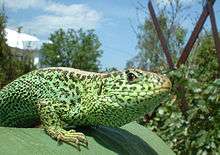Lacertidae
The Lacertidae are the family of the wall lizards, true lizards, or sometimes simply lacertas, which are native to Europe, Africa, and Asia. The group includes the genus Lacerta, which contains some of the most commonly seen lizard species in Europe. It is a diverse family with at least 300 species in 39 genera.
| Lacertids | |
|---|---|
 | |
| Sand lizard (Lacerta agilis) | |
| Scientific classification | |
| Kingdom: | Animalia |
| Phylum: | Chordata |
| Class: | Reptilia |
| Order: | Squamata |
| Superfamily: | Lacertoidea |
| Family: | Lacertidae Oppel, 1811 |
| Type species | |
| Lacerta agilis | |
| Subgroups | |
|
See text | |

Habitat
The European and Mediterranean species of lacertids live mainly in forest and scrub habitats.[1] Eremias and Ophisops species replace these in the grassland and desert habitats of Asia. African species usually live in rocky, arid areas. Holaspis species are among the few arboreal lacertids, and its two species, Holaspis guentheri and Holaspis laevis, are gliders (although apparently poor ones), using their broad tail and flattened body as an aerofoil.[2]
Description
Lacertids are small or medium-sized lizards. Most species are less than 9 cm long, excluding the tail, although the largest living species, Gallotia stehlini, reaches 46 cm, and some extinct forms were larger still. They are primarily insectivorous.[1] An exception is Meroles anchietae, one of the few wall lizards that regularly eat seeds – an appropriate food for a lizard of the harsh Namib Desert.
Lacertids are remarkably similar in form, with slender bodies and long tails, but have highly varied patterns and colours, even within the same species. Their scales are large on the head, which often also has osteoderms, small and granular on the back, and rectangular on the underside. Most species are sexually dimorphic, with the males and females having different patterns.[1]
At least eight species from the Caucasus are parthenogenetic,[3][4] and three species give birth to live young, including the viviparous lizard, Zootoca vivipara.[1]
Classification
The classification into subfamilies and tribes below follows one presented by Arnold et al., 2007, based on their phylogenetic analysis.[5]
Family Lacertidae
- Subfamily Gallotiinae
- Genus Gallotia (8 species)
- Genus Psammodromus (6 species)
- Subfamily Lacertinae
- Tribe Eremiadini
- Genus Acanthodactylus (42 species)
- Genus Adolfus (6 species)
- Genus Australolacerta (1 species)
- Genus Congolacerta (2 species)
- Genus Eremias (37 species)
- Genus Gastropholis (4 species)
- Genus Heliobolus (4 species)
- Genus Holaspis (2 species)
- Genus Ichnotropis (6 species)
- Genus Latastia (10 species)
- Genus Meroles (8 species)
- Genus Mesalina (19 species)
- Genus Nucras (12 species)
- Genus Ophisops (10 species)
- Genus Pedioplanis (13 species)
- Genus Philochortus (7 species)
- Genus Poromera (1 species)
- Genus Pseuderemias (7 species)
- Genus Tropidosaura (4 species)
- Tribe Lacertini
- Genus Algyroides (4 species)
- Genus Anatololacerta (4 species)
- Genus Apathya (2 species)
- Genus Archaeolacerta (1 species)
- Genus Atlantolacerta (1 species)
- Genus Dalmatolacerta (1 species)
- Genus Darevskia (34 species)
- Genus Dinarolacerta (2 species)
- Genus Hellenolacerta (1 species)
- Genus Iberolacerta (8 species)
- Genus Iranolacerta (2 species)
- Genus Lacerta (10 species)
- Genus Omanosaura (2 species)
- Genus Parvilacerta (2 species)
- Genus Phoenicolacerta (4 species)
- Genus Podarcis (23 species)
- Genus Scelarcis (1 species)
- Genus Takydromus (24 species)
- Genus Teira (1 species)
- Genus Timon (6 species)
- Genus Vhembelacerta (1 species)
- Genus Zootoca (1 species)
- Tribe Eremiadini
The latest extensive phylogenetic lacertid tree was made by Baeckens et al. in 2015.[6]
References
| Wikispecies has information related to Lacertidae |
| Wikimedia Commons has media related to Lacertidae. |
- Bauer, Aaron M. (1998). Cogger, H.G.; Zweifel, R.G. (eds.). Encyclopedia of Reptiles and Amphibians. San Diego: Academic Press. pp. 163–165. ISBN 978-0-12-178560-4.
- Zug et al. 2001
- Darevskii IS. 1967. Rock lizards of the Caucasus: systematics, ecology and phylogenesis of the polymorphic groups of Caucasian rock lizards of the subgenus Archaeolacerta. Nauka: Leningrad [in Russian: English translation published by the Indian National Scientific Documentation Centre, New Delhi, 1978].
- Tarkhnishvili DN (2012) Evolutionary History, Habitats, Diversification, and Speciation in Caucasian Rock Lizards. In: Advances in Zoology Research, Volume 2 (ed. Jenkins OP), Nova Science Publishers, Hauppauge (NY), p.79-120
- Arnold, E. Nicholas; Arribas, Oscar; Carranza, Salvador (2007). Systematics of the Palaearctic and Oriental lizard tribe Lacertini (Squamata: Lacertidae: Lacertinae), with descriptions of eight new genera (PDF). Zootaxa. 1430. pp. 1–86. ISBN 978-1-86977-097-6. Retrieved 12 July 2017.
- Baeckens, Simon (January 2015). "Chemical signalling in lizards: an interspecific comparison of femoral pore numbers in Lacertidae". Biological Journal of the Linnean Society. 114: 44–57. doi:10.1111/bij.12414.